Abstract
We have studied synergism between adrenaline (epinephrine) and low concentrations of thrombin in gel-filtered human platelets prelabelled with [32P]Pi. Suspensions of platelets, which did not contain added fibrinogen, were incubated at 37 degrees C to measure changes in the levels of 32P-labelled phosphatidylinositol 4,5-bisphosphate (PIP2), phosphatidylinositol 4-phosphate (PIP) and phosphatidate (PA), aggregation and dense-granule secretion after stimulation. Adrenaline alone (3.5-4.0 microM) did not cause a change in any parameter (phosphoinositide metabolism, aggregation and dense-granule secretion), but markedly enhanced the thrombin-induced responses over a narrow range of thrombin concentrations (0.03-0.08 units/ml). The thrombin-induced hydrolysis of inositol phospholipids by phospholipase C, which was measured as the formation of [32P]PA, was potentiated by adrenaline, as was the increase in the levels of [32P]PIP2 and [32P]PIP. The presence of adrenaline caused a shift to the left for the thrombin-induced changes in the phosphoinositide metabolism, without affecting the maximal levels of 32P-labelled compounds obtained. A similar shift by adrenaline in the dose-response relationship was previously demonstrated for thrombin-induced aggregation and dense-granule secretion. Also, the narrow range of concentrations of thrombin over which adrenaline potentiates thrombin-induced platelet responses is the same for changes in phosphoinositide metabolism and physiological responses (aggregation and dense-granule secretion). Our observations clearly indicate that adrenaline directly or indirectly influences thrombin-induced changes in phosphoinositide metabolism.
Full text
PDF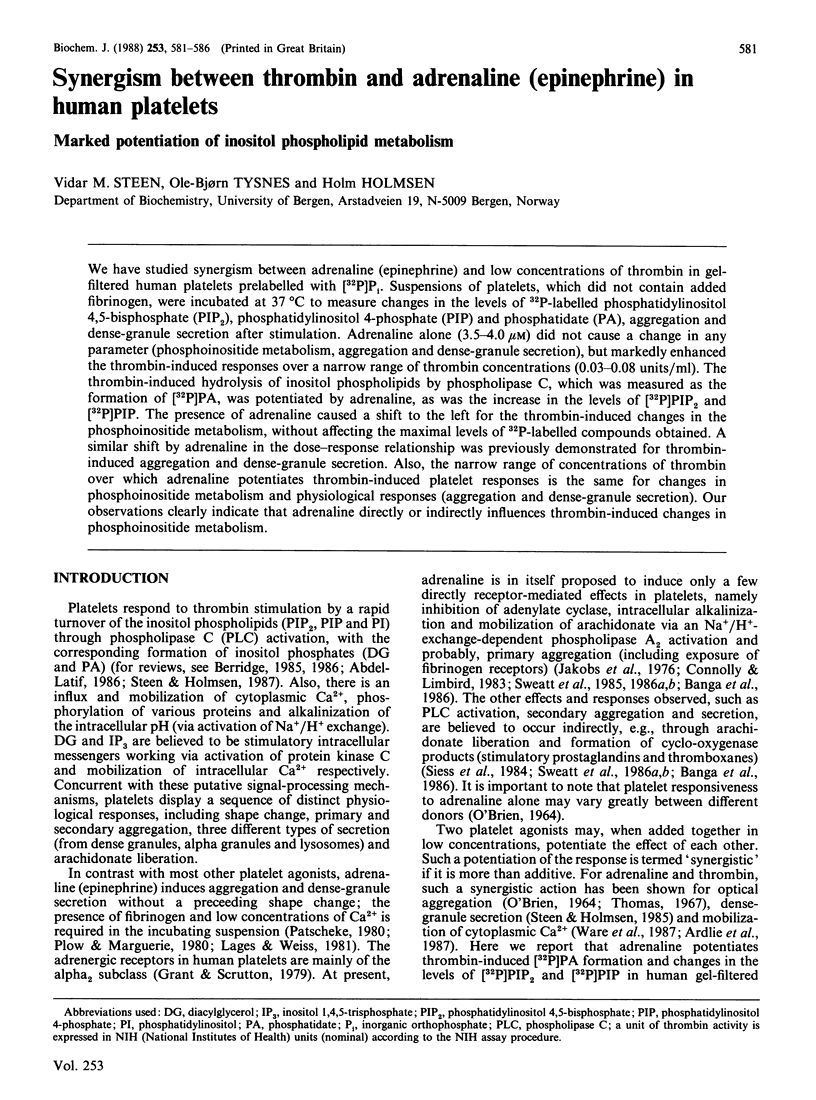
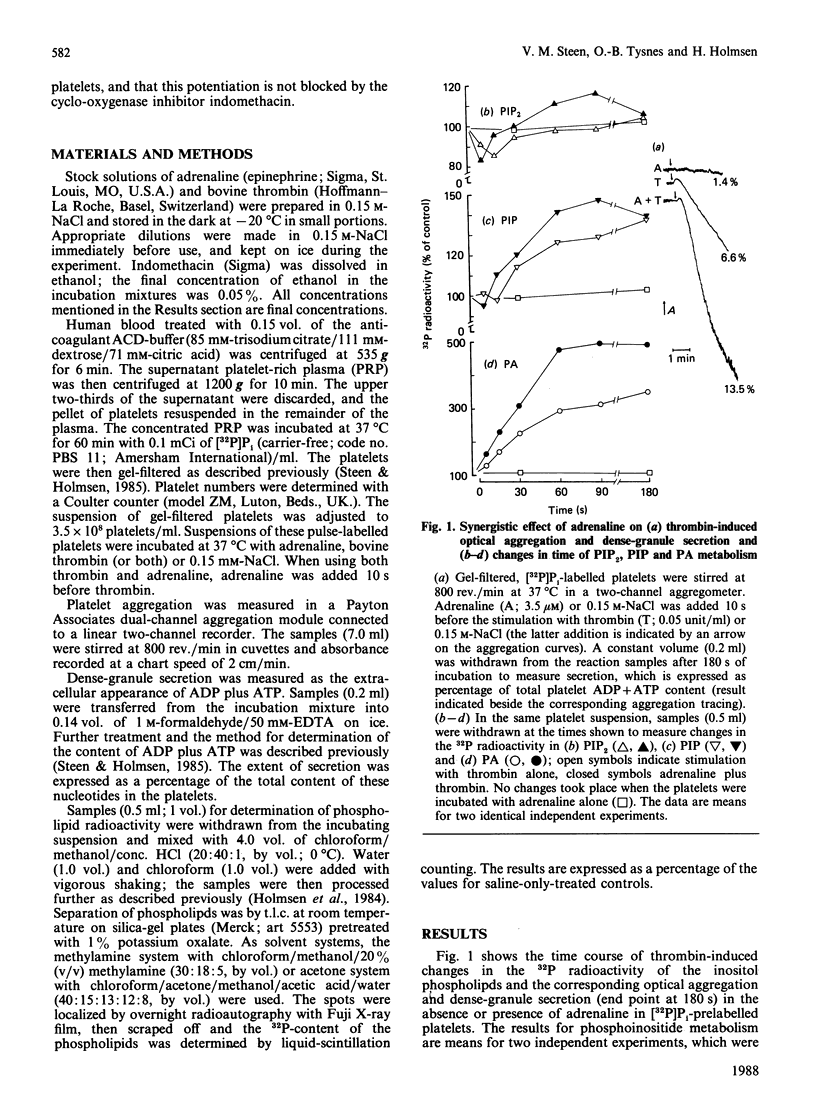
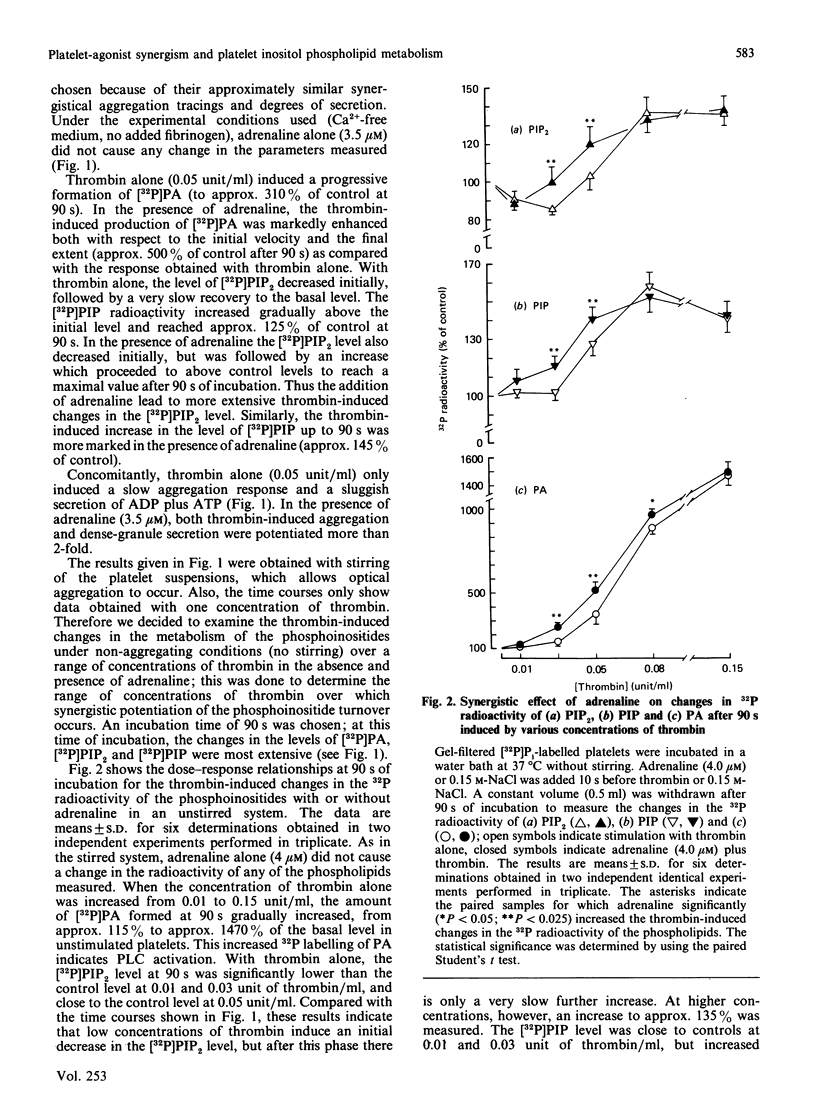
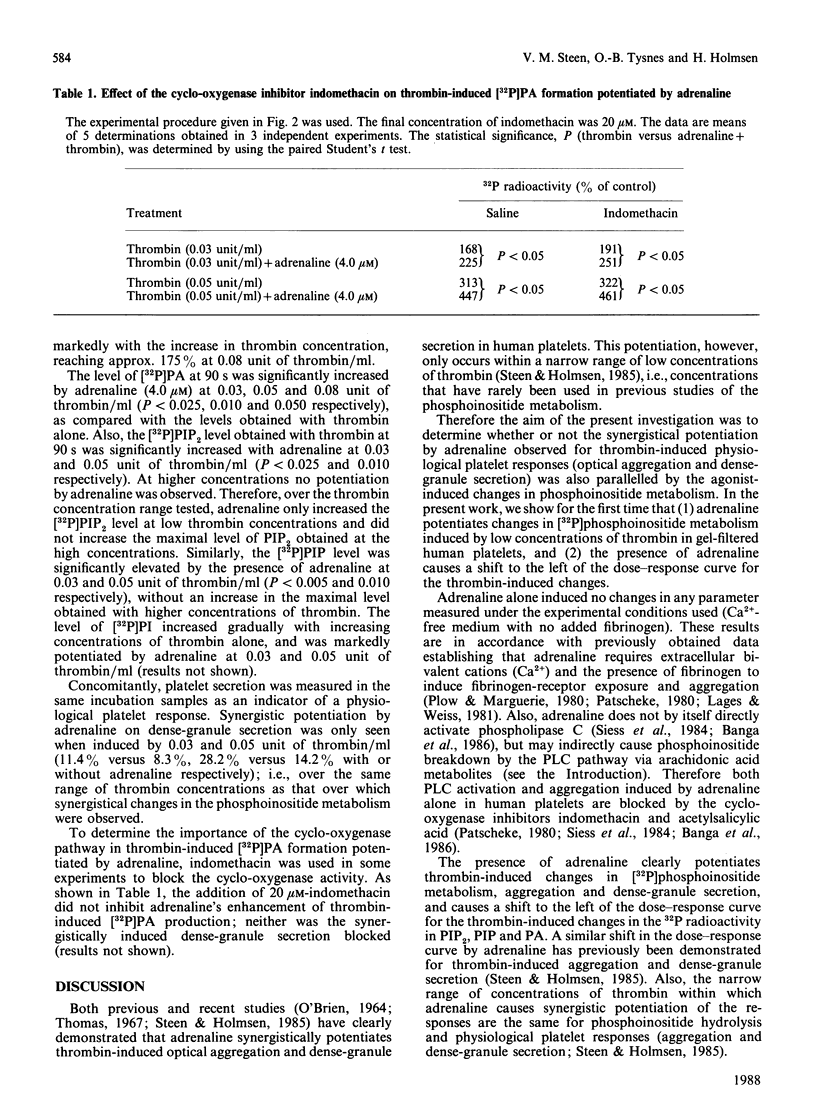

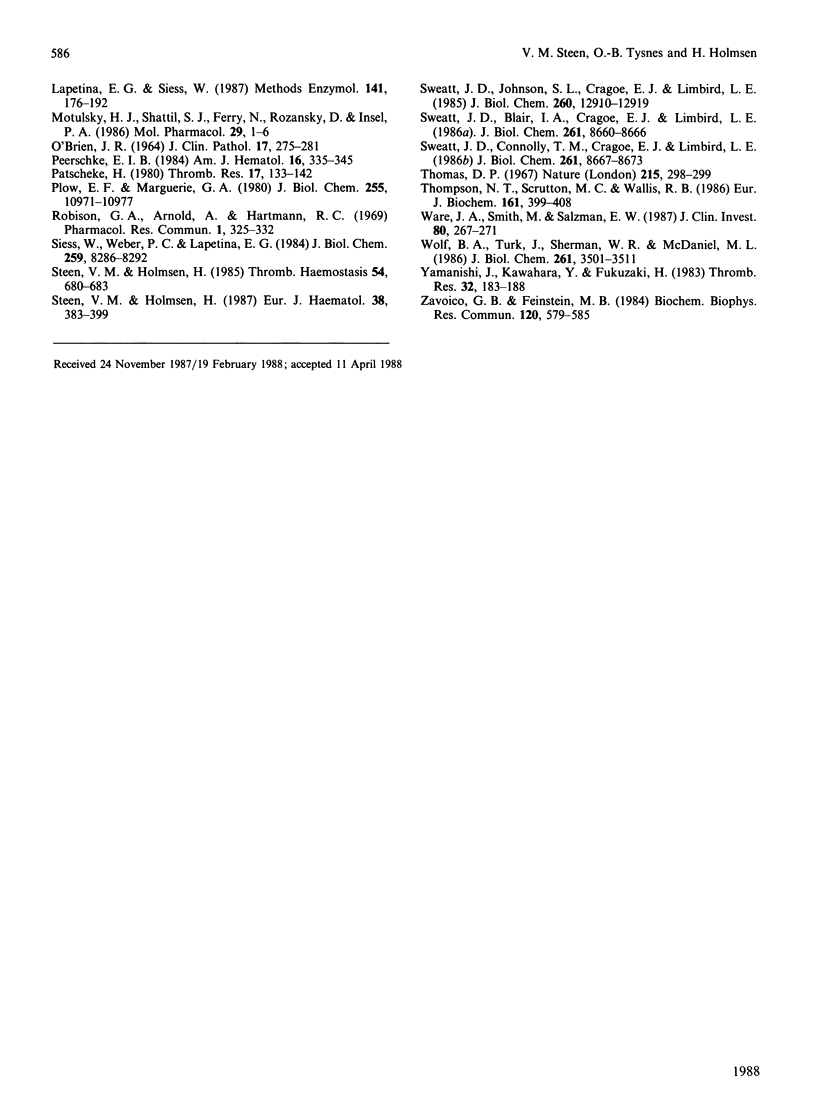
Selected References
These references are in PubMed. This may not be the complete list of references from this article.
- Abdel-Latif A. A. Calcium-mobilizing receptors, polyphosphoinositides, and the generation of second messengers. Pharmacol Rev. 1986 Sep;38(3):227–272. [PubMed] [Google Scholar]
- Aktories K., Jakobs K. H. Epinephrine inhibits adenylate cyclase and stimulates a GTPase in human platelet membranes via alpha-adrenoceptors. FEBS Lett. 1981 Aug 3;130(2):235–238. doi: 10.1016/0014-5793(81)81128-3. [DOI] [PubMed] [Google Scholar]
- Ardlie N. G., Bell L. K., McGuiness J. A. Synergistic potentiation by epinephrine of collagen or thrombin-induced calcium mobilization in human platelets. Thromb Res. 1987 May 15;46(4):519–526. doi: 10.1016/0049-3848(87)90153-8. [DOI] [PubMed] [Google Scholar]
- Banga H. S., Simons E. R., Brass L. F., Rittenhouse S. E. Activation of phospholipases A and C in human platelets exposed to epinephrine: role of glycoproteins IIb/IIIa and dual role of epinephrine. Proc Natl Acad Sci U S A. 1986 Dec;83(23):9197–9201. doi: 10.1073/pnas.83.23.9197. [DOI] [PMC free article] [PubMed] [Google Scholar]
- Berridge M. J. Cell signalling through phospholipid metabolism. J Cell Sci Suppl. 1986;4:137–153. doi: 10.1242/jcs.1986.supplement_4.9. [DOI] [PubMed] [Google Scholar]
- Bushfield M., McNicol A., MacIntyre D. E. Possible mechanisms of the potentiation of blood-platelet activation by adrenaline. Biochem J. 1987 Feb 1;241(3):671–676. doi: 10.1042/bj2410671. [DOI] [PMC free article] [PubMed] [Google Scholar]
- Connolly T. M., Limbird L. E. The influence of Na+ on the alpha 2-adrenergic receptor system of human platelets. A method for removal of extraplatelet Na+. Effect of Na+ removal on aggregation, secretion, and cAMP accumulation. J Biol Chem. 1983 Mar 25;258(6):3907–3912. [PubMed] [Google Scholar]
- Feinstein M. B., Egan J. J., Sha'afi R. I., White J. The cytoplasmic concentration of free calcium in platelets is controlled by stimulators of cyclic AMP production (PGD2, PGE1, forskolin). Biochem Biophys Res Commun. 1983 Jun 15;113(2):598–604. doi: 10.1016/0006-291x(83)91768-0. [DOI] [PubMed] [Google Scholar]
- Figures W. R., Scearce L. M., Wachtfogel Y., Chen J., Colman R. F., Colman R. W. Platelet ADP receptor and alpha 2-adrenoreceptor interaction. Evidence for an ADP requirement for epinephrine-induced platelet activation and an influence of epinephrine on ADP binding. J Biol Chem. 1986 May 5;261(13):5981–5986. [PubMed] [Google Scholar]
- Grant J. A., Scrutton M. C. Novel alpha2-adrenoreceptors primarily responsible for inducing human platelet aggregation. Nature. 1979 Feb 22;277(5698):659–661. doi: 10.1038/277659a0. [DOI] [PubMed] [Google Scholar]
- Holmsen H., Dangelmaier C. A., Rongved S. Tight coupling of thrombin-induced acid hydrolase secretion and phosphatidate synthesis to receptor occupancy in human platelets. Biochem J. 1984 Aug 15;222(1):157–167. doi: 10.1042/bj2220157. [DOI] [PMC free article] [PubMed] [Google Scholar]
- Holmsen H. Platelet metabolism and activation. Semin Hematol. 1985 Jul;22(3):219–240. [PubMed] [Google Scholar]
- Jakobs K. H., Saur W., Schultz G. Reduction of adenylate cyclase activity in lysates of human platelets by the alpha-adrenergic component of epinephrine. J Cyclic Nucleotide Res. 1976 Nov-Dec;2(6):381–392. [PubMed] [Google Scholar]
- Lages B., Weiss H. J. Dependence of human platelet functional responses on divalent cations: aggregation and secretion in heparin- and hirudin-anticoagulated platelet-rich plasma and the effects of chelating agents. Thromb Haemost. 1981 Apr 30;45(2):173–179. [PubMed] [Google Scholar]
- Lalau Keraly C., Vickers J. D., Kinlough-Rathbone R. L., Mustard J. F. Involvement of phosphoinositide metabolism in potentiation by adrenaline of ADP-induced aggregation of rabbit platelets. Biochem J. 1987 Mar 15;242(3):841–847. doi: 10.1042/bj2420841. [DOI] [PMC free article] [PubMed] [Google Scholar]
- Lanza F., Cazenave J. P. Studies of alpha 2-adrenergic receptors of intact and functional washed human platelets by binding of 3H-dihydroergocryptine and 3H-yohimbine--correlation of 3H-yohimbine binding with the potentiation by adrenaline of ADP-induced aggregation. Thromb Haemost. 1985 Aug 30;54(2):402–408. [PubMed] [Google Scholar]
- Lapetina E. G., Siess W. Measurement of inositol phospholipid turnover in platelets. Methods Enzymol. 1987;141:176–192. doi: 10.1016/0076-6879(87)41066-5. [DOI] [PubMed] [Google Scholar]
- Motulsky H. J., Shattil S. J., Ferry N., Rozansky D., Insel P. A. Desensitization of epinephrine-initiated platelet aggregation does not alter binding to the alpha 2-adrenergic receptor or receptor coupling to adenylate cyclase. Mol Pharmacol. 1986 Jan;29(1):1–6. [PubMed] [Google Scholar]
- O'BRIEN J. R. A COMPARISON OF PLATELET AGGREGATION PRODUCED BY SEVEN COMPOUNDS AND A COMPARISON OF THEIR INHIBITORS. J Clin Pathol. 1964 May;17:275–281. doi: 10.1136/jcp.17.3.275. [DOI] [PMC free article] [PubMed] [Google Scholar]
- Patscheke H. Role of activation in epinephrine-induced aggregation of platelets. Thromb Res. 1980 Jan 1;17(1-2):133–142. doi: 10.1016/0049-3848(80)90301-1. [DOI] [PubMed] [Google Scholar]
- Peerschke E. I. Effect of epinephrine on fibrinogen receptor exposure by aspirin-treated platelets and platelets from concentrates in response to ADP and thrombin. Am J Hematol. 1984 May;16(4):335–345. doi: 10.1002/ajh.2830160404. [DOI] [PubMed] [Google Scholar]
- Plow E. F., Marguerie G. A. Induction of the fibrinogen receptor on human platelets by epinephrine and the combination of epinephrine and ADP. J Biol Chem. 1980 Nov 25;255(22):10971–10977. [PubMed] [Google Scholar]
- Siess W., Weber P. C., Lapetina E. G. Activation of phospholipase C is dissociated from arachidonate metabolism during platelet shape change induced by thrombin or platelet-activating factor. Epinephrine does not induce phospholipase C activation or platelet shape change. J Biol Chem. 1984 Jul 10;259(13):8286–8292. [PubMed] [Google Scholar]
- Steen V. M., Holmsen H. Current aspects on human platelet activation and responses. Eur J Haematol. 1987 May;38(5):383–399. doi: 10.1111/j.1600-0609.1987.tb01434.x. [DOI] [PubMed] [Google Scholar]
- Steen V. M., Holmsen H. Synergism between thrombin and epinephrine in human platelets: different dose-response relationships for aggregation and dense granule secretion. Thromb Haemost. 1985 Oct 30;54(3):680–683. [PubMed] [Google Scholar]
- Sweatt J. D., Blair I. A., Cragoe E. J., Limbird L. E. Inhibitors of Na+/H+ exchange block epinephrine- and ADP-induced stimulation of human platelet phospholipase C by blockade of arachidonic acid release at a prior step. J Biol Chem. 1986 Jul 5;261(19):8660–8666. [PubMed] [Google Scholar]
- Sweatt J. D., Connolly T. M., Cragoe E. J., Limbird L. E. Evidence that Na+/H+ exchange regulates receptor-mediated phospholipase A2 activation in human platelets. J Biol Chem. 1986 Jul 5;261(19):8667–8673. [PubMed] [Google Scholar]
- Sweatt J. D., Johnson S. L., Cragoe E. J., Limbird L. E. Inhibitors of Na+/H+ exchange block stimulus-provoked arachidonic acid release in human platelets. Selective effects on platelet activation by epinephrine, ADP, and lower concentrations of thrombin. J Biol Chem. 1985 Oct 25;260(24):12910–12919. [PubMed] [Google Scholar]
- Thomas D. P. Effect of catecholamines on platelet aggregation caused by thrombin. Nature. 1967 Jul 15;215(5098):298–299. doi: 10.1038/215298a0. [DOI] [PubMed] [Google Scholar]
- Thompson N. T., Scrutton M. C., Wallis R. B. Synergistic responses in human platelets. Comparison between aggregation, secretion and cytosolic Ca2+ concentration. Eur J Biochem. 1986 Dec 1;161(2):399–408. doi: 10.1111/j.1432-1033.1986.tb10459.x. [DOI] [PubMed] [Google Scholar]
- Ware J. A., Smith M., Salzman E. W. Synergism of platelet-aggregating agents. Role of elevation of cytoplasmic calcium. J Clin Invest. 1987 Jul;80(1):267–271. doi: 10.1172/JCI113058. [DOI] [PMC free article] [PubMed] [Google Scholar]
- Wolf B. A., Turk J., Sherman W. R., McDaniel M. L. Intracellular Ca2+ mobilization by arachidonic acid. Comparison with myo-inositol 1,4,5-trisphosphate in isolated pancreatic islets. J Biol Chem. 1986 Mar 15;261(8):3501–3511. [PubMed] [Google Scholar]
- Yamanishi J., Kawahara Y., Fukuzaki H. Effect of cyclic AMP on cytoplasmic free calcium in human platelets stimulated by thrombin: direct measurement with quin2. Thromb Res. 1983 Oct 15;32(2):183–188. doi: 10.1016/0049-3848(83)90029-4. [DOI] [PubMed] [Google Scholar]
- Zavoico G. B., Feinstein M. B. Cytoplasmic Ca2+ in platelets is controlled by cyclic AMP: antagonism between stimulators and inhibitors of adenylate cyclase. Biochem Biophys Res Commun. 1984 Apr 30;120(2):579–585. doi: 10.1016/0006-291x(84)91294-4. [DOI] [PubMed] [Google Scholar]
- de Chaffoy de Courcelles D., Roevens P., Van Belle H., De Clerck F. The synergistic effect of serotonin and epinephrine on the human platelet at the level of signal transduction. FEBS Lett. 1987 Jul 27;219(2):283–288. doi: 10.1016/0014-5793(87)80236-3. [DOI] [PubMed] [Google Scholar]


